- News
- Reviews
- Bikes
- Components
- Bar tape & grips
- Bottom brackets
- Brake & gear cables
- Brake & STI levers
- Brake pads & spares
- Brakes
- Cassettes & freewheels
- Chains
- Chainsets & chainrings
- Derailleurs - front
- Derailleurs - rear
- Forks
- Gear levers & shifters
- Groupsets
- Handlebars & extensions
- Headsets
- Hubs
- Inner tubes
- Pedals
- Quick releases & skewers
- Saddles
- Seatposts
- Stems
- Wheels
- Tyres
- Tubeless valves
- Accessories
- Accessories - misc
- Computer mounts
- Bags
- Bar ends
- Bike bags & cases
- Bottle cages
- Bottles
- Cameras
- Car racks
- Child seats
- Computers
- Glasses
- GPS units
- Helmets
- Lights - front
- Lights - rear
- Lights - sets
- Locks
- Mirrors
- Mudguards
- Racks
- Pumps & CO2 inflators
- Puncture kits
- Reflectives
- Smart watches
- Stands and racks
- Trailers
- Clothing
- Health, fitness and nutrition
- Tools and workshop
- Miscellaneous
- Buyers Guides
- Features
- Forum
- Recommends
- Podcast
review
£1,499.99
VERDICT:
Quick like a road bike, comfy like a mountain bike, with disc brake confidence; a thoroughbred mongrel of an all-rounder
Weight:
10,480g
Contact:
www.cyclingsportsgroup.co.uk
At road.cc every product is thoroughly tested for as long as it takes to get a proper insight into how well it works. Our reviewers are experienced cyclists that we trust to be objective. While we strive to ensure that opinions expressed are backed up by facts, reviews are by their nature an informed opinion, not a definitive verdict. We don't intentionally try to break anything (except locks) but we do try to look for weak points in any design. The overall score is not just an average of the other scores: it reflects both a product's function and value – with value determined by how a product compares with items of similar spec, quality, and price.
What the road.cc scores meanGood scores are more common than bad, because fortunately good products are more common than bad.
- Exceptional
- Excellent
- Very Good
- Good
- Quite good
- Average
- Not so good
- Poor
- Bad
- Appalling
The Cannondale Quick 2 is an unusual combination of flat bars and carbon fibre frame, that will tackle just about anything from shopping to club runs.
This is the most costly option in Cannondale's Quick range, and the only one with a carbon frame and fork being sold in the UK.

If you like the concept but feel that you'd be happy without the low weight and high cost of the carbon or without the hydraulic disc brakes, the Quick SL 1 is £999.99 with a similar spec, aluminium frame and rim brakes. There are several far less lavishly equipped models bearing more in common with other hybrids starting at £449.99.
While £1500 might seem like a lot of money for a hybrid, a couple of local shops tell us this type of bike sells well to riders who want high speed and low weight but without dropped bars.
Cannondale describes the Quick as a bike that 'blurs the line between upright recreational comfort and thrilling road bike speed', but there's a lot more to it than that.

With rack mounts, two sets of bottle bosses and tough 32mm tyres, plus plenty room to go bigger, the Quick is perfectly capable of tackling gentle off road trails and could be a good basis for a lightweight tourer.
There's loads of stem and bar height adjustability too so you're not stuck with the high front end if you don't like it. We did a couple of rides with a 23in flat handlebar fitted and the stem the other way up.
This put the grips 70mm lower and created a flat backed ride posture that had more in common with a race bred road bike. But we know riders who'll love the riser handlebar just as it is, complete with casually comfy back-sweep and ergonomically shaped bolt-on grips that offer great support for riders who suffer from wrist pain.
Pedigree mongrel
If there was such a thing as a thoroughbred mongrel, the Cannondale Quick Carbon might be regarded as perfect breeding stock.
Its mountain bike-style aesthetics and riding position might initially confuse but it manages to blend many of the best aspects of quality mountain bikes, hybrids and competitive road bikes into a single tidy and lightweight package.

Assessing it for just what it is, rather than what it could be, there's obviously no reason at all why hybrid buyers should be restricted to the lower price categories, just as there's no reason at all for a stereotypical road rider to be restricted to dropped handlebar bikes.
Cannondale classifies the UK Quick range as 'Recreation' bikes. The category includes eleven bikes split into thee sub groups, including four models with suspension forks in a cyclo-cross group and seven rigid-forked aluminium and carbon framed Quicks with a strong focus on low weight.

The carbon frame and fork of our test sample features many of the design and performance attributes of Cannondale's more purist road bikes.
The drivetrain uses a compact crankset (50/34), the twin spoked (12 x 12) wheels are light but tough and it tipped our scales at a gnat's whisker under 23lb.
The riser handlebar and hydraulic disc brakes are the main features that differ radically from a purist road bike. The 700 x 32c Kenda Kwik Roller tyres add comfort and resilience to rough surfaces without overly detracting from speed.
The compact frame has masses of standover clearance and a long slim seat post that noticeably adds a little extra comfort to the back end. Its beautifully clean, moulded carbon shapes are enhanced by tidy graphics and the sort of smooth lines that you instantly want to touch.

The slimline 'SAVE' seat stays probably add more comfort to the back end and utilitarian purposes are well served by the bottle bosses, rack and mudguard eyelets.
The rear disc brake calliper is tucked between the seat and chain stays, clear of rack and 'guard eyelets. The gear cables and disc hoses are routed through the frame and fork, leaving nice clean lines throughout, but with easy access for re-routing via a weatherproof hatch under the bottom bracket.
Bedding in the brakes
Cannondale's Helix 6 hydraulic brakes are powerful and well modulated but took a couple of rides to properly bed in and reach their full potential. They needed a couple more rides before we were able to adjust the front brake calliper well enough to stop it rubbing slightly on one side or the other: the self-adjusting pads are closer to the rotor than on many other hydraulic discs.

Also, if you're speculating that you could move to a dropped handlebar at some point, bear in mind that you'd need to either downgrade to cable discs or upgrade the complete groupset to Ultegra electronic plus hydraulics. In terms of cost, that would not be a rational move.
The fine detail of componentry is well thought out, with the 2 x 10 drivetrain matched to Shimano Tiagra under-bar shifters, a Shimano 105 rear gear and a bracket mounted Tiagra mech up front.
The 12-30 cassette and FSA 50/34 crankset give a range of gears that should suit most riders and the press fit oversized (BB30) bottom brackets on Cannondales are relatively trouble free if well fitted by the shop: we've had some that creak within the first couple of rides because they were fitted totally dry.

Element Xero C3 CX wheels have a pretty good reputation in terms of stiffness and durability and the Kenda tyres are fast on the road but tough enough to take the brunt of some occasional trail abuse.
The 24in low rise handlebar was a popular choice for some riders, especially around town, but the more competitively inclined preferred a lower stem position and a flat handlebar.
The Cannondale branded stem, seat post and saddle are all nicely made and simple wide flat pedals are provided but we suspect a lot of riders would upgrade to their own pedal choice.
Ride: casual speed - road bike quick with mountain bike comfort
On black-top, the instantly most obvious and endearing characteristic of the Quick Carbon 2 is its casual speed. It initially accelerates with the ease of a fast road bike but in terms of ride position feels far more like a mountain bike.

The riser handlebar can be tilted further forward or back to fine tune your ride posture and there's about 50mm of fore/aft saddle rail positioning to play with. With the riser bar fitted most riders moved the 25mm steerer washer stack to the top of the stem so we ended up feeling that a flatter bar with some back-sweep would suit most riders better.
Powerful cruising or climbing are slightly more laboured than on a drop handlebar bike when you stay sitting down. If you want to really put your upper body into the climbs a slightly lower flat bar with bar ends would work better in most cases, although the riser bar is fine if you're standing up to climb.
The steering geometry is slightly more relaxed than on most race bred bikes but it combines with the taut feel of the fork, the frame and the wheels to create a handling character that's far more sprightly than most hybrid type bikes.
As it is, the Quick Carbon 2 seems like an ideal option for a rider who feels unhindered by price tags at the same time as feeling unconvinced by, or ill at ease with, the drop handlebar purist road bike approach.
We know a fair few riders like that, some with posture issues that make a dropped bar bike seem a step too far, others who simply prefer a relatively upright ride posture.
Either way, Cannondale and a few other brands have already shown that bikes like this are popular.
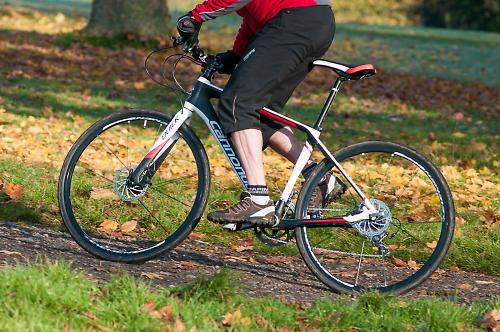
We've enjoyed the few off road sections we've tackled and we've ridden regular road routes just a kilometer or two per hour slower than we do on dropped bar bikes of similar heft and value.
With mudguards and a rack fitted, the Quick is a true all-rounder. Okay, you don't need to spend £1500 to get a good all rounder, but there aren't many around without dropped bars that weigh under 23lb and perform as well as this.
Conclusion
A light and lively hybrid with a quality carbon frame and fork, fun to ride and a great commuter if you have somewhere safe to leave it, but it also has enough all-rounder potential to tackle rapid club rides, light touring and easy off road trails.
Verdict
Quick like a road bike, comfy like a mountain bike, with disc brake confidence; a thoroughbred mongrel of an all-rounder.
road.cc test report
Make and model: Cannondale Quick Carbon 2
Size tested: Medium
About the bike
State the frame and fork material and method of construction. List the components used to build up the bike.
Carbon frame and fork. Xero C3 CX wheels with 32mm Kenda tyres. Cannondale hydraulic disc brakes. FSA 50/34 crankset. Shimano 105/Tiagra gears. Cannondale bar, stem, seat post and saddle.
Tell us what the bike is for, and who it's aimed at. What do the manufacturers say about it? How does that compare to your own feelings about the bike?
Cannondale list it in their 'Recreation' category but it's much more than just an urban hybrid. It's low weight makes it fast and lively on the road but it's also very capable on gentle off road terrain and it would be ideal for casual lightweight touring with a rack fitted.
Frame and fork
Overall rating for frame and fork
8/10
Tell us about the build quality and finish of the frame and fork?
Excellent build quality, well finished.
Tell us about the materials used in the frame and fork?
Carbon composite frame and fork.
Tell us about the geometry of the frame and fork?
71 head angle 74.5 seat angle. 56cm top tube length and 45cm seat tube length on Medium.
How was the bike in terms of height and reach? How did it compare to other bikes of the same stated size?
About average for a 'Medium' road bike but with the standover height of a mountain bike.
Riding the bike
Was the bike comfortable to ride? Tell us how you felt about the ride quality.
Casually comfortable, 32mm tyres meant a more forgiving ride than most road bikes. Not everyone appreciated the height of the riser handlebar but there's loads of adjustment and you could easily fit a flat handlebar.
Did the bike feel stiff in the right places? Did any part of the bike feel too stiff or too flexible?
Just right.
How did the bike transfer power? Did it feel efficient?
Excellent.
Was there any toe-clip overlap with the front wheel? If so, was it a problem?
No.
How would you describe the steering? Was it lively, neutral or unresponsive? Lively enough but never nervous.
Tell us some more about the handling. How did the bike feel overall? Did it do particular things well or badly?
Climbing in the saddle was harder work than on a drop handlebar equipped road bike but handling was superb in urban situations and surprisingly good on the few off road sections we rode.
Which components had the most effect (good or bad) on the bike's comfort? would you recommend any changes?
The riser handlebar is a big comfort bonus at slower speeds but it won't suit everyone. A flat bar with bar ends would add to speed efficiency on longer rides, especially on climbs.
Rate the bike for efficiency of power transfer:
7/10
Climbing in the saddle is harder work than on a bike with dropped bars.
Rate the bike for acceleration:
7/10
Rate the bike for sprinting:
7/10
Rate the bike for cruising speed stability:
8/10
Rate the bike for low speed stability:
9/10
Superb around town in traffic.
Rate the bike for flat cornering:
8/10
Rate the bike for cornering on descents:
8/10
Rate the bike for climbing:
6/10
Long climbs feel laboured with the riser handlebar fitted.
The drivetrain
Rate the drivetrain for performance:
9/10
Rate the drivetrain for durability:
9/10
Rate the drivetrain for weight:
8/10
Rate the drivetrain for value:
7/10
We've seen better drivetrain kit on a £1500 bike.
Wheels and tyres
Rate the wheels and tyres for performance:
8/10
Rate the wheels and tyres for durability:
8/10
Very tough tyres, good for rough roads.
Rate the wheels and tyres for weight:
7/10
Rate the wheels and tyres for comfort:
8/10
Rate the wheels and tyres for value:
7/10
Tell us some more about the wheels and tyres.Did they work well in the conditions you encountered? Would you change the wheels or tyres? If so, what for?
No complaints at all. Tough enough for occasional off road use but light enough for fast road use.
Controls
Rate the controls for performance:
7/10
Rate the controls for durability:
8/10
Rate the controls for weight:
7/10
Rate the controls for comfort:
7/10
Rate the controls for value:
7/10
Tell us some more about the controls. Any particularly good or bad components? How would the controls work for larger or smaller riders?
Loads of ride position adjustment in the bar/stem set-up.
Your summary
Did you enjoy riding the bike? Yes.
Would you consider buying the bike? No.
Would you recommend the bike to a friend? Yes.
Rate the bike overall for performance:
7/10
Rate the bike overall for value:
6/10
About the tester
Age: 58 Height: 181 Weight: 78kg
I usually ride: Merlin Ti My best bike is: Ibis Silk SL
I've been riding for: Over 20 years I ride: Every day I would class myself as: Expert
I regularly do the following types of riding: cyclo cross, commuting, touring, club rides, sportives, general fitness riding, fixed/singlespeed, mtb,
Latest Comments
- chrisonabike 4 hours 45 min ago
But is it compatible with elliptical chainrings?
- David9694 4 hours 47 min ago
Parking fail as car left teetering on top of stone wall Oh dear https://www.devonlive.com/news/local-news/parking-fail-car-left-teeterin...
- mctrials23 5 hours 19 min ago
"As a cyclist myself..."...
- chrisonabike 5 hours 21 min ago
Well, you could get a rusty omafiets (would you be happy for it to weight slightly more than double, assuming you've a fairly heavy road bike)? Or...
- chrisonabike 5 hours 29 min ago
Well, law isn't engineering......
- jaymack 6 hours 6 min ago
We must be related!
- The_Ewan 7 hours 35 min ago
But why worry if a few people do? It's just not a big deal....
- Tom_77 8 hours 39 min ago
Tempted to get him a sweary birthday cake like in The Thick Of It....
- Bigtwin 9 hours 8 min ago
Didn't happen did it? They came into my shop a couple of years back and said it was "on the way", but never heard anything more.
- Steve K 9 hours 40 min ago
Very parochially, I've still not forgiven Pearson's for abandoning their roots by leaving Sutton.




























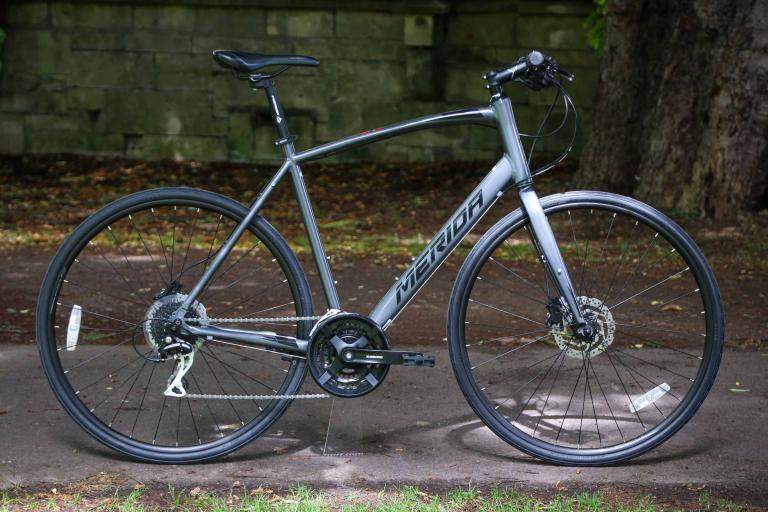
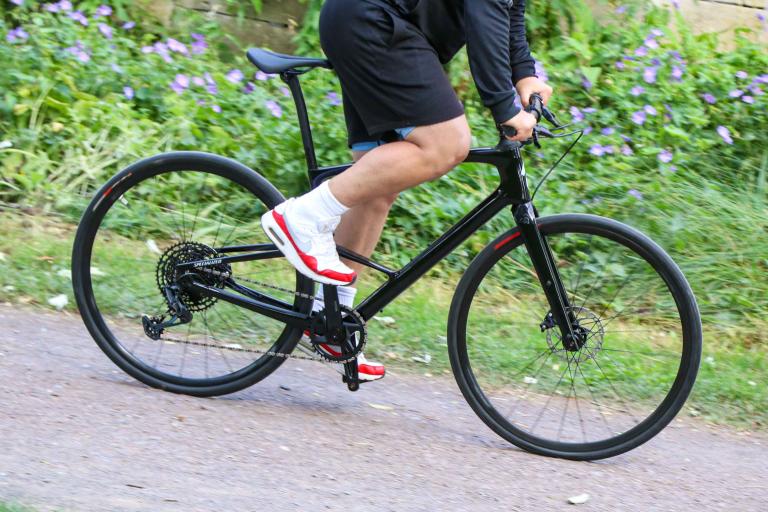
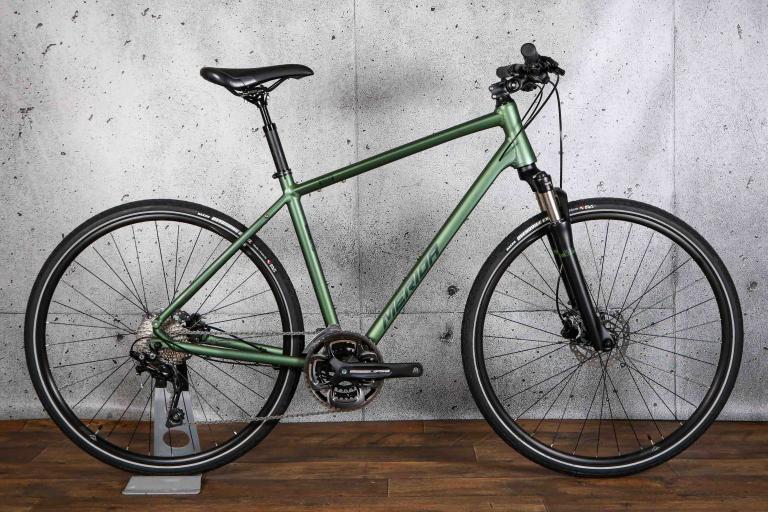
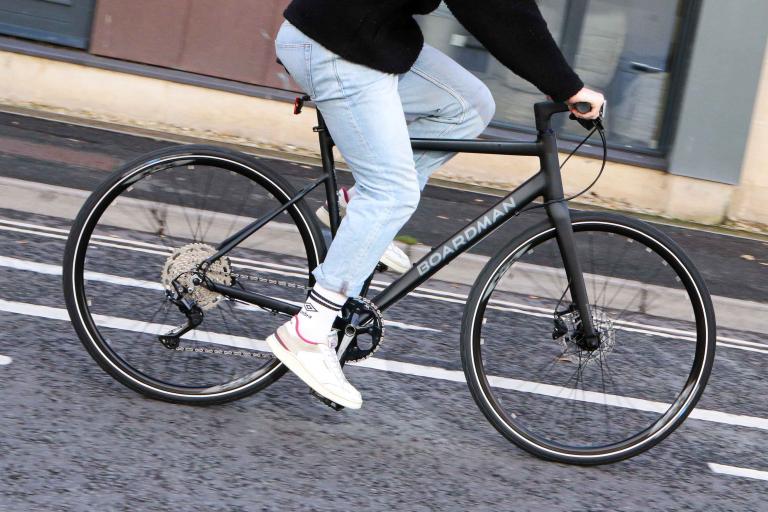
Add new comment
9 comments
Not to question personal preferences but I struggle to understand why so many regular cyclists have a problem with drop bars for general use, even in the city.
Surely if they are placed at the right height/distance they will be at least just as comfortable while offering more hand positions/versatility. Modern brake/shifter levers offer great ergonomics and excellent braking performance from the hoods.
I suspect that it's not the bars per se are a problem but the fact that on most of bikes they are placed too low. ?
Or perhaps it's a tribal/image thing...? Drop bars belong to the world of racing bikes...?
7000 miles on mine. In sun, rain, snow etc and some seriously rough, gravely and dirty roads...
..
I did pick up a creek in the last ride though Have not had a chance to diagnose yet, so could be cleets or a number of other things, but I might be back here in a couple of days to retract my comment
Have not had a chance to diagnose yet, so could be cleets or a number of other things, but I might be back here in a couple of days to retract my comment  but the bottom bracket has gone 7000 miles (or 11 265km in funny money) without trouble
but the bottom bracket has gone 7000 miles (or 11 265km in funny money) without trouble
What a joke - "the press fit oversized (BB30) bottom brackets on Cannondales are relatively trouble free"
Relative to what? Everyone I know who has bought a Cannondale with BB30 (including me, unfortunately) knows they are crap. 3000km max and they're buggered. Less if they get wet.
I have one of these bikes, bought for £1300 new.
The reason I bought this is for a fit bike i.e. just for 10-15 mile blasts for fitness at max speed in an urban environment.
I already have a Scott Spark 30 and a Cannondale Synapse and I use them for the purpose they are intended for road & trails and we all know you cant replace a road bike for the road or a mountain bike for the trails with any kind of hybrid.
I have had Discs out of my back and the lumber part fused so getting down on the drops is harder for me and many people I know with back issues say the same and you have more control with a riser bar in an urban ride.
I am 6'3 and 15st and ride the XL which is about half an inch longer on the top tube than my size 58 Synapse.
Don't expect this bike to accelerate like a road bike because it wont but once going its fine.
This bike will appeal to different people for different reasons much like people that come off a fast road bike as they get older but still want a good hybrid to go out on.
I look at this and just think that I'd really fancy something with a good quality lightweight frame and a hub-gear option.
I'd love to see a carbon Bad Boy with an eccentric BB and an Alfine 8 or 11speed. That would be an awesome commuter bike.
This looks very similar to Planet X's Dirty Disco.
When I read something like this which is an obvious lie, as these tyres are amongst the worst I have ever encountered, it casts some doubt over the rest of the article, so I stopped reading.
The only problem is you shell out £1500 on it and then after a couple of rides you realize you should have bought a road bike.
One assumes that most people dropping £1500 on a bike will already know that a flat bar is for them, for one of the reasons mentioned in the article. Rightly or wrongly (and I'd say very wrongly...) some people assume that drop bars are only for 'serious cyclists / lycramaniacs' and will go for a flat bar. It's interesting that there is no triple option for this bike though.
Your principle is sound though... I spent £450 on my Scott a few years back and knew very quickly that I should have bought a proper MTB...
Looks interesting for sure, ideal for longer distance commutes.
I've got a similar setup - specialized cross trail with kona p2 rigid fork, 2 x 10 tiagra/ ultegra road transmission, fulcrum road wheels with conti 4 season tires and carbon flat bar - most importantly SKS full length mudguards!
Gets funny looks but I do 250km a week commuting and my sporty hybrid is the first choice..my specialized tarmac gets left behind unless the weather is A1 quality!
The ability to ride in foul weather whilst not getting sprayed, and the aggressive riding position (surprisingly stretched and low front for hybrid) with constant cover of brakes (xt v brakes) makes it fast but secure going through heavily congested urban streets
I've converted a good number of drop bar road bikes to flat bars for customers so there is definitely a market for sports hybrid's